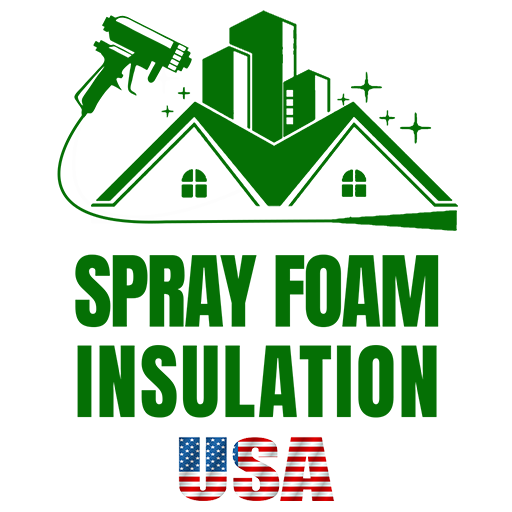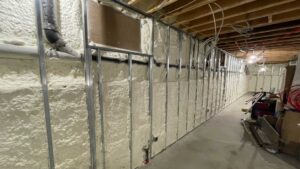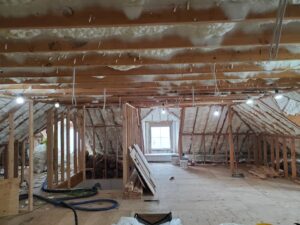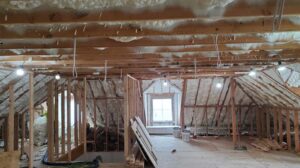Should I insulate my attic floor or ceiling? This is a key question for many homeowners and business owners striving for better energy efficiency and comfort in their properties. Here’s a quick guide to help you decide:
- Insulate the attic floor if you mainly use the attic for storage or it’s an unused space. This helps keep the living spaces below warm and reduces heat loss.
- Insulate the attic ceiling if you plan to convert the attic into a living space or for temperature-sensitive storage. It helps maintain a stable temperature within the attic itself.
Attic insulation is not just a home improvement task; it’s a crucial investment towards creating an energy-efficient, comfortable, and cost-effective living and working environment. Whether you’re reaping the benefits of lower energy bills, reducing your carbon footprint, or enhancing the livability of your indoor spaces, understanding the importance of proper attic insulation is essential.

In our rapidly shifting climate, ensuring that your attic is well insulated can dramatically improve the thermal efficiency of your building, turning it into a year-round comfort zone. Let’s dive deeper into the intricacies of choosing the right typeof attic insulation to meet your needs.
Choosing Between Attic Floor and Ceiling Insulation
When deciding whether to insulate the attic floor or ceiling, several factors come into play, including energy savings, temperature control, and cost-effectiveness. Each choice has its own benefits and ideal applications depending on your attic’s use and your home’s specific needs.
Insulating the Attic Floor
Cost-effectiveness: Insulating the attic floor is generally more affordable and less labor-intensive than insulating the ceiling. It’s an effective solution if the attic is not used as a living space and primarily serves as a buffer zone to reduce heat transfer between the house and the roof.
Vented attics: For homes with vented attics, insulating the floor can help maintain a clear separation between the conditioned air in your living spaces and the unconditioned attic space. This setup prevents warm air from escaping into the attic during winter and keeps cool air from seeping out during summer.
Storage space: If your attic is used for storage, insulating the floor means that while the attic space itself may not be conditioned, it still provides a protective layer that helps manage the temperature in the living areas below more effectively.
Insulating the Attic Ceiling
Unvented attics: In cases where the attic forms part of the living area or if plans are in place to convert it into a habitable space, insulating the attic ceiling is the better option. This approach creates an unvented attic, which is sealed and conditioned just like any other room in the house.
Temperature-sensitive storage: If you store items that are sensitive to temperature fluctuations, such as photographs, musical instruments, or electronics, an insulated attic ceiling can help maintain a stable environment that protects these items from extreme temperatures.
HVAC efficiency: Insulating the attic ceiling can also improve the efficiency of your heating, ventilation, and air conditioning (HVAC) system by stabilizing the attic’s temperature. This reduces the workload on your HVAC system, leading to potentially lower energy bills and a longer lifespan for the system.
In conclusion, the decision on whether to insulate the attic floor or ceiling hinges on your specific needs such as cost, usage of the attic, and the desired energy efficiency. Both options offer significant benefits, but the right choice will depend on your particular circumstances and future plans for the space. Moving forward, understanding the dynamics of ventilation and the insulation products available will further guide your decision-making process.
Understanding Ventilation and Insulation Products
When deciding whether to insulate your attic floor or ceiling, understanding the role of ventilation and the types of insulation products available is crucial. This knowledge will help you make an informed choice that enhances your home’s energy efficiency and comfort.
Vented vs. Unvented Attics
Airflow in your attic plays a significant role in its overall efficiency and the health of your home. Here’s what you need to know about the two main types of attics:
-
Vented Attics: These attics allow air to flow freely in and out, which helps prevent moisture buildup and regulates temperature. Insulating the attic floor in vented attics is common since it helps keep the living spaces below warm and reduces energy costs.
-
Unvented Attics: An unvented attic uses an airtight seal created by insulating the attic ceiling. This setup restricts air exchange to controlled, mechanical ventilation. This can be beneficial for maintaining consistent temperatures and protecting stored items that might be sensitive to temperature fluctuations.
Insulation Products Overview
Choosing the right insulation product depends on the type of attic and your specific needs. Here are the most common insulation types:
-
Spray Foam: This is a versatile option that can be used for both vented and unvented attics. Spray foam expands to fill gaps, providing excellent air sealing and insulation. It’s ideal for creating an airtight environment in unvented attics.
-
Batt Insulation: Often made from fiberglass or mineral wool, batt insulation is suitable for easy-to-reach spaces and standard joist layouts. It’s commonly used in vented attics where maintaining some airflow is necessary.
-
Blown-in Insulation: Perfect for covering irregular spaces and filling in around obstructions, blown-in insulation is often used in attic floors. It provides a thick layer of insulation that can significantly reduce heat transfer.
-
Air-sealing Products: No matter the insulation type, air-sealing is critical to maximize its effectiveness. These products help seal leaks and gaps where air might enter or escape, enhancing the overall energy efficiency of your home.
Understanding these options and how they interact with different attic types will guide you in making the best decision for insulating your attic. Whether you choose spray foam for its airtight seal or prefer the traditional batt insulation for its simplicity and effectiveness, the goal is the same: to improve your home’s comfort and reduce energy costs.
Moving forward, addressing common attic insulation questions will help clarify any remaining uncertainties, ensuring you are fully prepared to make the best insulation choice for your attic.
Addressing Common Attic Insulation Questions
When considering whether to insulate your attic, several common questions arise, particularly regarding heat loss, vapor barriers, and cold bridging. Understanding these factors will help you decide should I insulate my attic floor or ceiling and what additional measures you might need to take.
Should I Insulate Between the Rafters?
Insulating between the rafters is a pivotal question for homeowners looking to manage heat effectively within their attics. Here’s what you need to know:
-
Minimizing Heat Loss: Insulating between the rafters can significantly reduce heat loss, especially in colder climates. This is because it helps keep the heat within the living spaces below, rather than allowing it to escape through the roof.
-
Pitched Roof Insulation: For homes with pitched roofs, insulating between the rafters creates a semi-conditioned space in the attic. This is particularly beneficial if you plan to use the attic as a living space or if it houses temperature-sensitive equipment.

Is a Vapor Barrier Necessary?
The necessity of a vapor barrier depends largely on your climate and the specific conditions in your attic:
-
Climate Considerations: In humid climates, a vapor barrier is crucial to prevent moisture from penetrating the insulation, which can lead to mold growth and reduced insulation efficiency.
-
Plastic Vapor Barriers: These are typically installed on the warm side of the insulation — facing the interior of your home — to prevent moisture from passing through.
-
Latex Ceiling Paint: An alternative to traditional plastic barriers, specially formulated latex paints can act as a vapor retarder. This is a practical solution when plastic sheeting is impractical.
Understanding these aspects of attic insulation helps in preventing common issues such as mold growth and energy inefficiency. By considering the specific needs of your home, such as whether to insulate between the rafters and the necessity of a vapor barrier, you can significantly enhance your home’s comfort and reduce ongoing energy costs.
Next, we’ll explore how these considerations play into making the right insulation choices for your attic to ensure optimal effectiveness and efficiency.
Making the Right Insulation Choice for Your Attic
Spray Foam Insulation USA
When you’re deciding should I insulate my attic floor or ceiling, think about how you plan to use your attic in the future. This choice impacts not just your energy bills but also how comfortably you can use your space.
Future Attic Use
If you’re considering turning your attic into a livable space, or even if you just want it as a storage area, how you insulate it matters. Insulating the attic floor is generally best for those who plan to keep the attic mostly for storage. This method keeps the living spaces below warm and reduces the risk of heat rising and escaping through the attic.
However, if you’re thinking about converting your attic into a living space, insulating the ceiling (roof) might be the way to go. This approach helps maintain a more consistent temperature in the attic itself, turning it into a comfortable room.
Protected Volume
The volume of space you need to protect and keep conditioned is crucial in deciding whether to insulate the floor or ceiling. Insulating the attic floor means you’re focusing on protecting the living space below from temperature fluctuations. On the other hand, insulating the attic ceiling expands the protected volume to include the attic, which could be beneficial if the attic is used frequently.
Insulation Placement
Proper insulation placement is key. For attics, placing insulation in the floor can help prevent warm air from escaping from the living spaces below during winter. In contrast, ceiling insulation is best for when you want to keep the attic itself warm, such as if it’s used as a living space.
Eco-Friendly Solutions
Choosing Spray Foam Insulation USA means opting for eco-friendly solutions that not only save you money on energy bills but also contribute to a healthier planet. Our spray foam products are designed to provide maximum insulation with minimal environmental impact.
Sustainable Insulation Services
At Spray Foam Insulation USA, we’re committed to sustainability. Our services are designed to enhance your home’s energy efficiency without compromising on quality or environmental responsibility. We use products that are not only effective but also sustainably sourced and applied.
Making the right insulation choice for your attic involves considering how you will use the space, the volume you need to protect, and where to place the insulation for maximum effectiveness. With Spray Foam Insulation USA, you can rest assured that you’re choosing a service that prioritizes both your comfort and the planet’s well-being. By focusing on sustainable, high-quality insulation solutions, we help ensure that your home remains comfortable, energy-efficient, and environmentally friendly year-round.
Conclusion
As we wrap up our discussion on whether should I insulate my attic floor or ceiling, it’s clear that the decision hinges on energy efficiency and how you plan to use your attic. Insulating either the floor or the ceiling of your attic can significantly enhance your home’s overall energy performance, but the right choice depends on your specific needs and future plans for the space.
Energy Efficiency: A Key Benefit
By choosing the right type of insulation for your attic, whether it’s the floor or the ceiling, you’re making a substantial investment in energy efficiency. Insulation acts as a barrier that reduces the amount of heat lost in winter and keeps your home cooler in the summer. This not only makes your living space more comfortable but also reduces the strain on your heating and cooling systems, leading to lower utility bills.
Planning for Attic Usage
Before deciding on insulation, consider how you intend to use the attic. If it’s solely for storage, floor insulation might be sufficient. However, if you plan to convert the space into a livable area, or if it houses HVAC equipment, insulating the ceiling could be more beneficial. This approach helps maintain a consistent temperature in the attic, protecting any stored items that might be sensitive to extreme temperatures and improving the overall efficiency of heating and cooling systems.
Choosing Spray Foam Insulation USA
At Spray Foam Insulation USA, we understand the importance of tailoring insulation solutions to fit each homeowner’s unique needs. Our spray foam insulation not only offers superior energy efficiency but also enhances the comfort of your home. With our expert installation, you can expect a seamless process that leaves you with a well-insulated attic that saves on energy costs and contributes to a healthier environment.
In conclusion, making the right choice between insulating your attic floor or ceiling depends on your specific needs and how you plan to use the space. With Spray Foam Insulation USA, you’re choosing a partner who values your comfort and energy efficiency as much as you do. We’re here to help guide you through every step of the process, ensuring that your attic insulation project enhances your home’s efficiency and comfort for years to come.





